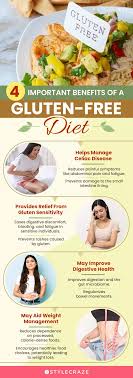Okay, so I’ve been hearing a lot about gluten-free diets lately. Everyone’s talking about it, from celebrities to that one super-fit neighbor who always seems to be jogging. I figured, why not give it a shot myself? See what all the fuss is about. I’m not celiac or anything, but I’ve had some digestive weirdness, so I thought, “maybe this is the answer!”

The Experiment Begins
First thing I did was clear out my pantry. Bye-bye, beloved pasta, bread, and even some sneaky sauces that had gluten hiding in them. It was like a food exorcism. I stocked up on gluten-free alternatives: rice pasta, almond flour bread, and a bunch of quinoa. I was ready to roll…or so I thought.
The First Few Days: Oh Boy
The first couple of days were…rough. I felt like I was constantly hungry. That satisfying fullness you get from a big bowl of pasta? Gone. Replaced by this weird, empty feeling. I craved bread like crazy. I even had a dream about a giant croissant chasing me!
Also, reading labels became my new full-time job. Gluten is in EVERYTHING. Seriously, check your soy sauce! It was exhausting.
Getting the Hang of It (Sort Of)
After about a week, I started to get used to it. I found some gluten-free bread that wasn’t awful (though it cost a small fortune). I experimented with different recipes, and discovered that cauliflower pizza crust isn’t as tragic as it sounds. I also started to notice some positive changes. My stomach felt less bloated, and I had a bit more energy. Hmmm, maybe there was something to this gluten-free thing after all.
I started the change slowly.

- Week 1: I began by identifying sources of gluten in the meals I consume. I used the internet a lot.
- Week 2: I went to a store that sells gluten free alternatives like rice pasta.
- Week 3: I found some gluten-free bread that wasn’t awful.
- Week 4: I tried different recipes like cauliflower pizza.
The Downsides: Not All Sunshine and Rainbows
But it wasn’t all perfect. Eating out became a minefield. Explaining “gluten-free” to waiters sometimes felt like I was speaking another language. And forget about spontaneous pizza nights with friends – I had to plan ahead like I was organizing a military operation. Social events were tricky, too. People kept offering me food I couldn’t eat, and I felt like a party pooper constantly saying “no.”
The Verdict?
So, after a month of gluten-free living, what’s the conclusion? Well, it’s complicated. I did feel better overall, and the digestive issues improved. But the restrictions were tough, and the social aspect was a real challenge. It also got pretty pricey. I think for people with celiac disease or a serious gluten sensitivity, it’s a no-brainer. But for me, I’m not sure it’s a sustainable lifestyle. Maybe I’ll try a “gluten-reduced” approach instead. Baby steps, right? We’ll see how it goes!